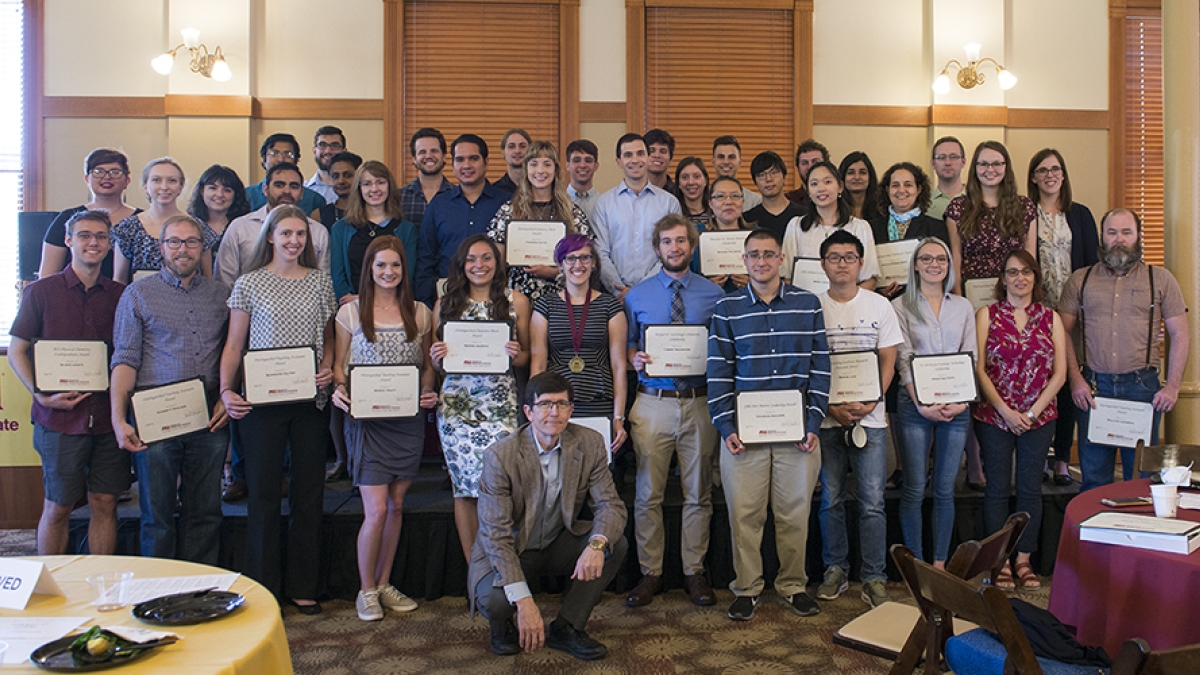Awards ceremony recognizes students, instructors and faculty for excellence in academics and research

The School of Molecular Sciences 2019 award and scholarship recipients.
The 2019 Annual Awards Ceremony hosted by Arizona State University’s School of Molecular Sciences was held on Monday, April 22, at Old Main on the Tempe campus to recognize faculty, teaching assistants, research and distinguished students.
Awards were presented to recognize undergraduate and graduate students who demonstrated excellence in academics and research. Each recipient was presented their award by a selected faculty member who shared their academic achievements.
The School of Molecular Sciences awarded five scholarships funded by generous gifts from donors throughout the year and on Sun Devil Giving Day, along with several endowed memorial scholarships, including the inaugural recipients of the Theodore M. Brown Memorial Scholarship and the School of Molecular Sciences Innovation Award.
“Every year we recognize students in the School of Molecular Sciences who have demonstrated academic and research excellence at the Annual Awards Ceremony,” said Neal Woodbury, director of the School of Molecular Sciences. “This year’s group of recipients exemplifies all of what SMS and ASU has to offer. ASU will be well represented in the chemistry and biochemistry fields in the future.”
To mark the occasion and celebrate, donors and families of the named endowed scholarships were invited to attend the luncheon ceremony. In attendance were Professor Emeritus Bill Glaunsinger, assistant dean for sciences and the professions in the Emeritus College, who presented the new School of Molecular Sciences Innovation Award; David Rasely, who presented the Theodore M. Brown Memorial Scholarship for his brother Brian; Kay Krause, daughter of Therald Moeller; Randy Hughes from the Arizona Society for Coatings Technology; and Linda Riash, director of development for the natural sciences, and Brendan Cunningham, assistant director of development for the natural sciences, who have been instrumental in supporting School of Molecular Sciences scholarships.
“My future academic plans are to earn a Doctor of Pharmacy at the University of Arizona and return to my hometown of Tuba City to fill a pharmacist position at Tuba City Regional Health Care,” said Stacee Tallman, recipient of the Theodore M. Brown Scholarship. “This scholarship will be a big help to getting my degree.”
This year the School of Molecular Sciences presented 13 of the most talented and deserving students with scholarships to support their academic goals. Eighteen undergraduates and graduate students were also recognized for the excellent work they have done at the School of Molecular Sciences. Alexis Ramirez, a biochemistry major, was selected as the fall 2018 Dean’s Medalist and Zoe Lieberman-Martin, a chemistry major, was selected as the spring 2018 Dean’s Medalist.
“I am incredibly honored to be receiving the Dean's Medal. As I prepare to graduate, I realize how lucky I am to have studied at a university with a faculty that is so dedicated to the success of its students. After attending school for a career in the arts, I hesitantly decided to return to Arizona to pursue scientific studies,” Lieberman-Martin said. “Earning this award assures me that I made the right decision and it contributes to a greater confidence in my abilities. I know that my passion for learning and persistence will enable me to conquer any challenges as I continue in the field of chemistry.”
The ceremony also included a presentation of accomplished graduate awards including the John Kacoyannakis Award, the LeRoy Eyring Memorial Fellowship in Chemistry, the George Yuen Memorial Award, the John Holloway Memorial Graduate Scholarship, Outstanding Graduate Research Assistant, the SMS Innovation Award and Distinguished Teaching Assistant awards.
The Distinguished Instructor award was presented to Professor Agota Debreczeni, and Professor Marcia Levitus was selected by Student Affiliates of the American Chemical Society (SAACS) for the 2019 Distinction of Merit and Scholastic Occupation (DMSO) Faculty Teaching Award.
“SAACS believes that Dr. Levitus is deserving of the DMSO Award because of her devotion to her students,” said Carolyn Clark, SAACS co-president. “She shows genuine concern for her students, asks for feedback on her teaching, and makes every effort to learn her students' names. She is motivating and engaging, and serves as a true inspiration to everyone she teaches.”
The School of Molecular Sciences and its generous supporters recognize the impact scholarships and awards make in contributing to the success of their students. Recognizing and supporting the brightest and the best students financially benefits not only ASU, but our whole community.
Learn more about School of Molecular Sciences scholarships.
View photos of awardees, presenting faculty and donors and families.
Full list of award and scholarship recipients:
George M. Bateman Memorial Scholarship: Tanaya Haws
Therald Moeller Scholarship: Elinor Sauer
Wayne W. Luchsinger Chemistry Scholarship: Tommy Saunders
John Holloway Memorial Scholarship (Undergraduate): William Knight
Edward B. Skibo Memorial Scholarship: Carolyn Clark
Theodore M. Brown Memorial Scholarship: Stacee Tallman
Arizona Society for Coatings Technology Scholarship: Krisztina Tope
School of Molecular Sciences Scholarship: David Flesher
School of Molecular Sciences Scholarship: Christopher Ramirez
School of Molecular Sciences Women in Science Scholarship: Annmarie Barton
School of Molecular Sciences Women in Science Scholarship: Missy Tran
School of Molecular Sciences First Generation Scholarship: Jasmine Nguyen
School of Molecular Sciences Scholarship for Veterans: Joseph Miller
School of Molecular Sciences Peer Mentor Leadership Award: Charles Amador
SAACS Organic Achievement Award: Julia Torline
ACS Division of Analytical Chemistry Undergraduate Award: Bridger Johnston
ACS Division of Inorganic Chemistry Undergraduate Award: Madeline Howell
ACS Division of Organic Chemistry Undergraduate Award: Michael Ruta
ACS Division of Physical Chemistry Undergraduate Award: Blake Hance
Royal Society of Chemistry Certificate of Excellence: Samantha Sokal
Distinguished Chemistry Merit Award: Vanessa Davis
Distinguished Chemistry Merit Award: Sierra Murphy
Distinguished Biochemistry Merit Award: Kimberly Kevershan
Distinguished Biochemistry Merit Award: Anne Schmidt
Dean’s Medal, fall 2018: Alexis Ramirez
Dean’s Medal, spring 2019: Zoe Lieberman-Martin
John Kacoyannakis Award: Claire Crowther
John Kacoyannakis Award: Mohammed Towshif Rabbani
LeRoy Eyring Memorial Fellowship in Chemistry: Miyuki Thirumuthy
George Yuen Memorial Award: Brian Wadsworth
John Holloway Memorial Scholarship (Graduate): Joshua Nye
Outstanding Graduate Research Assistant Award: Fan Hong and Renjie Liao
SMS Innovation Award: David Ciota
Distinguished Teaching Assistant Award: Rafael Alcala-Torano, Samantha Donovan, Michael Furey, Shannon Hilton, William Johnson, Nikita Kumari, Aerial Pratt, Edgar A. Reyes Cruz, Garrett Shaver, Spencer Smith, Stephanie Thibert
Distinguished Instructor Award: Agota Debreczeni
Distinction of Merit and Scholastic Occupation (DMSO) Teaching Award: Marcia Levitus
More Science and technology

Cracking the code of online computer science clubs
Experts believe that involvement in college clubs and organizations increases student retention and helps learners build valuable…
Consortium for Science, Policy & Outcomes celebrates 25 years
For Arizona State University's Consortium for Science, Policy & Outcomes (CSPO), recognizing the past is just as important as…

Hacking satellites to fix our oceans and shoot for the stars
By Preesha KumarFrom memory foam mattresses to the camera and GPS navigation on our phones, technology that was developed for…